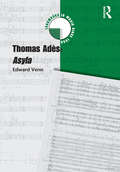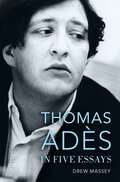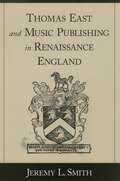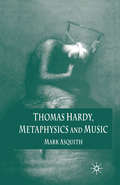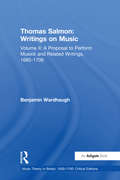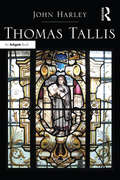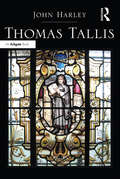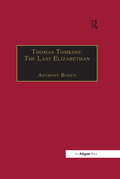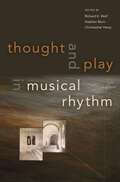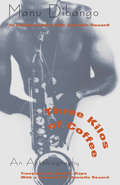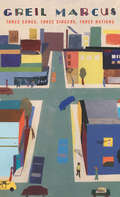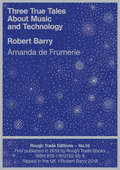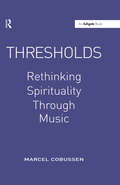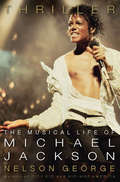- Table View
- List View
Thomas Adès: Asyla (Landmarks in Music Since 1950)
by Edward VennThomas Adès (b. 1971) is an established international figure, both as composer and performer, with popular and critical acclaim and admiration from around the world. Edward Venn examines in depth one of Adès’s most significant works so far, his orchestral Asyla (1997). Its blend of virtuosic orchestral writing, allusions to various idioms, including rave music, and a musical rhetoric encompassing both high modernism and lush romanticism is always compelling and utterly representative of Adès’s distinctive compositional voice. The reception of Asyla since its premiere in 1997 by Sir Simon Rattle and the City of Birmingham Symphony Orchestra (CBSO) has been staggering. Instantly hailed as a classic, Asyla won the 1997 Royal Philharmonic Society Award for Large-Scale Composition. An internationally acclaimed recording made of the work was nominated for the 1999 Mercury Music Prize, and in 2000, Adès became the youngest composer (and only the third British composer) to win the Grawemeyer prize, for Asyla. Asyla is fast becoming a repertory item, rapidly gaining over one hundred performances: a rare distinction for a contemporary work.
Thomas Adès: Asyla (Landmarks in Music Since 1950)
by Edward VennThomas Adès (b. 1971) is an established international figure, both as composer and performer, with popular and critical acclaim and admiration from around the world. Edward Venn examines in depth one of Adès’s most significant works so far, his orchestral Asyla (1997). Its blend of virtuosic orchestral writing, allusions to various idioms, including rave music, and a musical rhetoric encompassing both high modernism and lush romanticism is always compelling and utterly representative of Adès’s distinctive compositional voice. The reception of Asyla since its premiere in 1997 by Sir Simon Rattle and the City of Birmingham Symphony Orchestra (CBSO) has been staggering. Instantly hailed as a classic, Asyla won the 1997 Royal Philharmonic Society Award for Large-Scale Composition. An internationally acclaimed recording made of the work was nominated for the 1999 Mercury Music Prize, and in 2000, Adès became the youngest composer (and only the third British composer) to win the Grawemeyer prize, for Asyla. Asyla is fast becoming a repertory item, rapidly gaining over one hundred performances: a rare distinction for a contemporary work.
Thomas Adès in Five Essays
by Drew MasseyThe British composer, conductor, and pianist Thomas Adès has achieved a level of recognition and celebrity within the world of classical music today that is almost unmatched. Once seen as the heir to Benjamin Britten, both in his importance to British music and his reputation as the enfant terrible of the concert world, Adès is a fascinating figure of contemporary composition. Reaching for the music behind the celebrity, author Drew Massey deftly tackles the challenges of writing about a living figure with such far-reaching impact by focusing on representative moments in his compositional career and critical reception. In this series of five interlocking essays, Massey provides an illuminating look at the formal characteristics of Adès's music, considers his work from the perspective of a contemporary listener, and places it within the larger context of developments in twentieth-century British music. He not only traces the diverse historical forms and traditions that Adès taps into but also reflects on where he is steering the future of composition and performance. An analysis of the key transitions in the artist's critical reception completes this book as the most comprehensive study of this pivotal figure of contemporary classical music in the English language to this day.
Thomas Adès in Five Essays
by Drew MasseyThe British composer, conductor, and pianist Thomas Adès has achieved a level of recognition and celebrity within the world of classical music today that is almost unmatched. Once seen as the heir to Benjamin Britten, both in his importance to British music and his reputation as the enfant terrible of the concert world, Adès is a fascinating figure of contemporary composition. Reaching for the music behind the celebrity, author Drew Massey deftly tackles the challenges of writing about a living figure with such far-reaching impact by focusing on representative moments in his compositional career and critical reception. In this series of five interlocking essays, Massey provides an illuminating look at the formal characteristics of Adès's music, considers his work from the perspective of a contemporary listener, and places it within the larger context of developments in twentieth-century British music. He not only traces the diverse historical forms and traditions that Adès taps into but also reflects on where he is steering the future of composition and performance. An analysis of the key transitions in the artist's critical reception completes this book as the most comprehensive study of this pivotal figure of contemporary classical music in the English language to this day.
Thomas East and Music Publishing in Renaissance England
by Jeremy L. SmithIn the London of Shakespeare and William Byrd, Thomas East was the premier, often exclusive, printer of music. As he tells the story of this influential figure in early English music publishing, Jeremy Smith also offers a vivid overall portrait of a bustling and competitive industry, in which composers, patrons, publishers, and tradesmen sparred for creative control and financial success. It provides a truly comprehensive study of music publishing and a new way of understanding the place of musical culture in Elizabethan times. In addition, Smith has compiled the first complete chronology of East's music prints, based on both bibliographical and paper-based evidence.
Thomas Hardy, Metaphysics and Music
by Mark AsquithThis fascinating new study by Mark Asquith offers an original approach to Hardy's art as a novelist and entirely new readings of certain musical scenes in Hardy's works. Asquith utilizes a rich seam of original archival research (both scientific and musicological), which will be of use to all Hardy scholars, and discusses a range of Hardy's major works in relation to musical metaphors - from early fiction The Poor Man and the Lady to later major works Jude the Obscure, Far From the Madding Crowd, the Mayor of Casterbridge .
Thomas Salmon: Volume II: A Proposal to Perform Musick and Related Writings, 1685-1706
by Benjamin WardhaughThis is the second volume in a two-part set on the writings of Thomas Salmon. Salmon (1647-1706) is remembered today for the fury with which Matthew Locke greeted his first foray into musical writing, the Essay to the Advancement of Musick (1672), and the near-farcical level to which the subsequent pamphlet dispute quickly descended. Salmon proposed a radical reform of musical notation, involving a new set of clefs which he claimed, and Locke denied, would make learning and performing music much easier (these writings are the subject of Volume I). Later in his life Salmon devoted his attention to an exploration of the possible reform of musical pitch. He made or renewed contact with instrument-makers and performers in London, with the mathematician John Wallis, with Isaac Newton and with the Royal Society of London through its Secretary Hans Sloane. A series of manuscript treatises and a published Proposal to Perform Musick, in Perfect and Mathematical Proportions (1688) paved the way for an appearance by Salmon at the Royal Society in 1705, when he provided a demonstration performance by professional musicians using instruments specially modified to his designs. This created an explicit overlap between the spaces of musical performance and of experimental performance, as well as raising questions about the meaning and the source of musical knowledge similar to those raised in his work on notation. Benjamin Wardhaugh presents the first published scholarly edition of Salmon's writings on pitch, previously only available mostly in manuscript.
Thomas Salmon: Volume II: A Proposal to Perform Musick and Related Writings, 1685-1706
by Benjamin WardhaughThis is the second volume in a two-part set on the writings of Thomas Salmon. Salmon (1647-1706) is remembered today for the fury with which Matthew Locke greeted his first foray into musical writing, the Essay to the Advancement of Musick (1672), and the near-farcical level to which the subsequent pamphlet dispute quickly descended. Salmon proposed a radical reform of musical notation, involving a new set of clefs which he claimed, and Locke denied, would make learning and performing music much easier (these writings are the subject of Volume I). Later in his life Salmon devoted his attention to an exploration of the possible reform of musical pitch. He made or renewed contact with instrument-makers and performers in London, with the mathematician John Wallis, with Isaac Newton and with the Royal Society of London through its Secretary Hans Sloane. A series of manuscript treatises and a published Proposal to Perform Musick, in Perfect and Mathematical Proportions (1688) paved the way for an appearance by Salmon at the Royal Society in 1705, when he provided a demonstration performance by professional musicians using instruments specially modified to his designs. This created an explicit overlap between the spaces of musical performance and of experimental performance, as well as raising questions about the meaning and the source of musical knowledge similar to those raised in his work on notation. Benjamin Wardhaugh presents the first published scholarly edition of Salmon's writings on pitch, previously only available mostly in manuscript.
Thomas Tallis: His Life And Music
by John HarleyJohn Harley’s Thomas Tallis is the first full-length book to deal comprehensively with the composer’s life and works. Tallis entered the Chapel Royal in the middle of a long life, and remained there for over 40 years. During a colourful period of English history he famously served King Henry VIII and the three of Henry’s children who followed him to the throne. His importance for English music during the second half of the sixteenth century is equalled only by that of his pupil, colleague and friend William Byrd. In a series of chronological chapters, Harley describes Tallis’s career before and after he entered the Chapel. The fully considered biography is placed in the context of larger political and cultural changes of the period. Each monarch’s reign is treated with an examination of the ways in which Tallis met its particular musical needs. Consideration is given to all of Tallis’s surviving compositions, including those probably intended for patrons and amateurs beyond the court, and attention is paid to the context within which they were written. Tallis emerges as a composer whose music displays his special ability in setting words and creating ingenious musical patterns. A table places most of Tallis’s compositions in a broad chronological order.
Thomas Tallis: His Life And Music
by John HarleyJohn Harley’s Thomas Tallis is the first full-length book to deal comprehensively with the composer’s life and works. Tallis entered the Chapel Royal in the middle of a long life, and remained there for over 40 years. During a colourful period of English history he famously served King Henry VIII and the three of Henry’s children who followed him to the throne. His importance for English music during the second half of the sixteenth century is equalled only by that of his pupil, colleague and friend William Byrd. In a series of chronological chapters, Harley describes Tallis’s career before and after he entered the Chapel. The fully considered biography is placed in the context of larger political and cultural changes of the period. Each monarch’s reign is treated with an examination of the ways in which Tallis met its particular musical needs. Consideration is given to all of Tallis’s surviving compositions, including those probably intended for patrons and amateurs beyond the court, and attention is paid to the context within which they were written. Tallis emerges as a composer whose music displays his special ability in setting words and creating ingenious musical patterns. A table places most of Tallis’s compositions in a broad chronological order.
Thomas Tallis
by John HarleyJohn Harley’s Thomas Tallis is the first full-length book to deal comprehensively with the composer’s life and works. Tallis entered the Chapel Royal in the middle of a long life, and remained there for over 40 years. During a colourful period of English history he famously served King Henry VIII and the three of Henry’s children who followed him to the throne. His importance for English music during the second half of the sixteenth century is equalled only by that of his pupil, colleague and friend William Byrd. In a series of chronological chapters, Harley describes Tallis’s career before and after he entered the Chapel. The fully considered biography is placed in the context of larger political and cultural changes of the period. Each monarch’s reign is treated with an examination of the ways in which Tallis met its particular musical needs. Consideration is given to all of Tallis’s surviving compositions, including those probably intended for patrons and amateurs beyond the court, and attention is paid to the context within which they were written. Tallis emerges as a composer whose music displays his special ability in setting words and creating ingenious musical patterns. A table places most of Tallis’s compositions in a broad chronological order.
Thomas Tallis: His Life And Music
by John HarleyJohn Harley’s Thomas Tallis is the first full-length book to deal comprehensively with the composer’s life and works. Tallis entered the Chapel Royal in the middle of a long life, and remained there for over 40 years. During a colourful period of English history he famously served King Henry VIII and the three of Henry’s children who followed him to the throne. His importance for English music during the second half of the sixteenth century is equalled only by that of his pupil, colleague and friend William Byrd. In a series of chronological chapters, Harley describes Tallis’s career before and after he entered the Chapel. The fully considered biography is placed in the context of larger political and cultural changes of the period. Each monarch’s reign is treated with an examination of the ways in which Tallis met its particular musical needs. Consideration is given to all of Tallis’s surviving compositions, including those probably intended for patrons and amateurs beyond the court, and attention is paid to the context within which they were written. Tallis emerges as a composer whose music displays his special ability in setting words and creating ingenious musical patterns. A table places most of Tallis’s compositions in a broad chronological order.
Thomas Tomkins: The Last Elizabethan
by Anthony BodenThomas Tomkins (1572-1656), a major figure of the Golden Age of British music, was arguably the greatest of all Welsh-born composers. Living through one of the most revolutionary periods in British history, his professional life was spent in the service of the Crown and the Church at both the Chapel Royal and Worcester Cathedral. Surviving the Civil War, the suppression of the music of the English Church, the closure of the Chapel Royal, the destruction of his organ at Worcester and the devastation of the city, Tomkins was able to find the strength and inspiration to continue composing secular music of fine quality. Much of Tomkins's output has survived, including his collection of music for the Anglican rite, Musica Deo Sacra, published posthumously in 1668. His work embraced both sacred and secular vocal music, pieces for keyboard and for viol consort, thereby proving him to be one of the most versatile figures of English Renaissance music. The first part of the book provides an absorbing biography of Tomkins, setting his life into fascinating historical context. The second and third parts include major essays on Tomkins by Denis Stevens, Bernard Rose, Peter James and David Evans, all authorities on the music of the period with each providing perceptive insights into Tomkins's music. The result is a successful piece of collective work that properly places Tomkins and his achievements in his time and enables readers to reassess him properly in relation to his elders and contemporaries. Tomkins has still not reached the 'household name' status of his great teacher, William Byrd, or of his close friend and colleague, Orlando Gibbons, but he is undoubtedly worthy of much greater recognition. The book complements the increasing number of live performances and recordings of Tomkins's music, both sacred and secular, and such a comprehensive account of the man and his work should appeal to early music scholars, performers and music lovers alike.
Thomas Tomkins: The Last Elizabethan
by Anthony Boden Denis Stevens Bernard Rose Peter James David R.A. EvansThomas Tomkins (1572-1656), a major figure of the Golden Age of British music, was arguably the greatest of all Welsh-born composers. Living through one of the most revolutionary periods in British history, his professional life was spent in the service of the Crown and the Church at both the Chapel Royal and Worcester Cathedral. Surviving the Civil War, the suppression of the music of the English Church, the closure of the Chapel Royal, the destruction of his organ at Worcester and the devastation of the city, Tomkins was able to find the strength and inspiration to continue composing secular music of fine quality. Much of Tomkins's output has survived, including his collection of music for the Anglican rite, Musica Deo Sacra, published posthumously in 1668. His work embraced both sacred and secular vocal music, pieces for keyboard and for viol consort, thereby proving him to be one of the most versatile figures of English Renaissance music. The first part of the book provides an absorbing biography of Tomkins, setting his life into fascinating historical context. The second and third parts include major essays on Tomkins by Denis Stevens, Bernard Rose, Peter James and David Evans, all authorities on the music of the period with each providing perceptive insights into Tomkins's music. The result is a successful piece of collective work that properly places Tomkins and his achievements in his time and enables readers to reassess him properly in relation to his elders and contemporaries. Tomkins has still not reached the 'household name' status of his great teacher, William Byrd, or of his close friend and colleague, Orlando Gibbons, but he is undoubtedly worthy of much greater recognition. The book complements the increasing number of live performances and recordings of Tomkins's music, both sacred and secular, and such a comprehensive account of the man and his work should appeal to early music scholars, performers and music lovers alike.
Thought and Play in Musical Rhythm
Thought and Play in Musical Rhythm offers new understandings of musical rhythm through the analysis and comparison of diverse repertoires, performance practices, and theories as formulated and transmitted in speech or writing. Editors Richard K. Wolf, Stephen Blum, and Christopher Hasty address a productive tension in musical studies between universalistic and culturally relevant approaches to the study of rhythm. Reacting to commonplace ideas in (Western) music pedagogy, the essays explore a range of perspectives on rhythm: its status as an "element" of music that can be usefully abstracted from timbre, tone, and harmony; its connotations of regularity (or, by contrast, that rhythm is what we hear against the grain of background regularity); and its special embodiment in percussion parts. Unique among studies of musical rhythm, the collection directs close attention to ways performers and listeners conceptualize aspects of rhythm and questions many received categories for describing rhythm. By drawing the ear and the mind to tensions, distinctions, and aesthetic principles that might otherwise be overlooked, this focus on local concepts enables the listener to dispel assumptions about how music works "in general." Readers may walk away with a few surprises, become more aware of their assumptions, and/or think of new ways to shock their students out of complacency.
THOUGHT & PLAY IN MUSICAL RHYTHM C
by Richard K. Wolf, Stephen Blum, and Christopher HastyThought and Play in Musical Rhythm offers new understandings of musical rhythm through the analysis and comparison of diverse repertoires, performance practices, and theories as formulated and transmitted in speech or writing. Editors Richard K. Wolf, Stephen Blum, and Christopher Hasty address a productive tension in musical studies between universalistic and culturally relevant approaches to the study of rhythm. Reacting to commonplace ideas in (Western) music pedagogy, the essays explore a range of perspectives on rhythm: its status as an "element" of music that can be usefully abstracted from timbre, tone, and harmony; its connotations of regularity (or, by contrast, that rhythm is what we hear against the grain of background regularity); and its special embodiment in percussion parts. Unique among studies of musical rhythm, the collection directs close attention to ways performers and listeners conceptualize aspects of rhythm and questions many received categories for describing rhythm. By drawing the ear and the mind to tensions, distinctions, and aesthetic principles that might otherwise be overlooked, this focus on local concepts enables the listener to dispel assumptions about how music works "in general." Readers may walk away with a few surprises, become more aware of their assumptions, and/or think of new ways to shock their students out of complacency.
A Thousand Threads: The NEW 2024 must-read memoir from the trail-blazing musician, activist and icon
by Neneh CherryThe joyous and electric memoir from beloved music icon Neneh CherryA GUARDIAN MOST ANTICIPATED BOOK OF 2024A BBC CULTURE MOST ANTICIPATED BOOK OF 2024‘Intoxicating . . . Seductive’ SUNDAY TIMES‘Fabulous’ VOGUETop of the Pops, December 1988. The world sat up as a young woman made her debut: gold bra, gold bomber jacket, and proudly, gloriously, seven months pregnant. This was no ordinary artist. This was Neneh Cherry.But navigating fame and family wasn't always simple. In this beautiful and deeply personal memoir, Cherry remembers the collaborations, the highs and lows, the friendships and loves, and the addictions and traumas that have shaped her as a woman and an artist. At the heart of it, always, is family: the extraordinary three generations of artists and musicians that are her inheritance and her legacy.Musician. Songwriter. Collaborator. Activist. Mother. Daughter. Lover. Friend. Icon. This is her story. The perfect Christmas gift for all music and art lovers.'I loved it' ZADIE SMITH 'Thrums with life' GUARDIAN'A living testament to artistic invention' OBSERVER
Three Kilos of Coffee: An Autobiography (Black Literature And Culture Ser.)
by Manu Dibango Danielle RouardIn 1948, at the age of fifteen, Manu Dibango left Africa for France, bearing three kilos of coffee for his adopted family and little else. This book chronicles Manu Dibango's remarkable rise from his birth in Douala, Cameroon, to his worldwide success—with Soul Makossa in 1972—as the first African musician ever to record a top 40s hit. Composer, producer, performer, film score writer and humanitarian for the poor, Manu Dibango defines the "African sound" of modern world music. He has worked with and influenced such artists as Art Blakey, Don Cherry, Herbie Hancock, Harry Belafonte, Paul Simon, and Johnny Clegg. In Africa, he has helped younger musicians, performed benefit concerts, and transcribed for the first time the scores and lyrics of African musicians. The product of a "mixed marriage" (of different tribes and religions) who owes allegiances to both Africa and Europe, Dibango has always been aware of the ambiguities of his identity. This awareness has informed all of the important events of his life, from his marriage to a white Frenchwoman in 1957, to his creation of an "Afro-music" which joyfully blends blues, jazz, reggae, traditional European and African serenades, highlife, Caribbean and Arabic music. This music addresses the meaning of "Africanness" and what it means to be a Black artist and citizen of the world. This lively and thoughtful memoir is based on an extensive set of interviews in 1989 with French journalist Danielle Rouard. Richly illustrated with photographs, this book will be a must for readers of jazz biographies, students of African music and ethnomusicology, and all those who are lovers of Manu Dibango's unique artistry and accomplishments.
Three Songs, Three Singers, Three Nations (The William E. Massey Sr. lectures in the history of American civilization ; #2013)
by Greil MarcusGreil Marcus delves into three distinct episodes in the history of American commonplace song and shows how each one manages to convey the uncanny sense that it was written by no one. In these seemingly anonymous productions, we discover three different ways of talking about the United States, and three separate nations within its borders.
Three Songs, Three Singers, Three Nations (The William E. Massey Sr. lectures in the history of American civilization ; #2013)
by Greil MarcusGreil Marcus delves into three distinct episodes in the history of American commonplace song and shows how each one manages to convey the uncanny sense that it was written by no one. In these seemingly anonymous productions, we discover three different ways of talking about the United States, and three separate nations within its borders.
Three True Tales About Music and Technology (Rough Trade Edition)
by Robert BarryHave you heard the story about the android that took to the operatic stage of eighteenth century London? Of the inventor who used musical chords to power an engine and fire a canon? What about the composer who helped the most beautiful woman in the world build a missile guidance system? Three True Tales About Music and Technology re-imagines these episodes from the sometimes tumultuous history of interactions between the sonic arts and technoscience as a series of folk tales and fairy stories—that just so happen to be true.
Thresholds: Rethinking Spirituality Through Music
by Marcel CobussenIn Thresholds Marcel Cobussen rethinks the relationship between music and spirituality. The point of departure is the current movement within contemporary classical music known as New Spiritual Music, with as its main representatives Arvo P John Tavener, and Giya Kancheli. In almost all respects, the musical principles of the new spiritual music seem to be diametrically opposed to those of modernism: repetition and rest versus development and progress, tradition and familiarity versus innovation and experiment, communication versus individualism and conceptualism, tonality versus atonality, and so on. As such, this movement is often considered as part of the much larger complex called postmodernism. Joining in with ideas on spirituality as presented by Michel de Certeau and Mark C. Taylor, Cobussen deconstructs the classification of the 'spiritual dimensions' of music as described above. Thresholds presents an idea of spirituality in and through music that counters strategies of exclusion and mastering of alterity and connects it to wandering, erring, and roving. Using the philosophy of Martin Heidegger, Georges Bataille, Jean-Fran‘s Lyotard, Jacques Derrida and others, and analysing the music of John Coltrane, the mythical Sirens, Arvo P and The Eagles (to mention a few), Cobussen regards spirituality as a (non)concept that escapes categorization, classification, and linguistic descriptions. Spirituality is a-topological, non-discursive and a manifestation of 'otherness'. And it is precisely music (or better: listening to music) that induces these thoughts: by carefully encountering, analysing, and evaluating certain examples from classical, jazz, pop and world music it is possible to detach spirituality from concepts of otherworldliness and transcendentalism. Thresholds opens a space in which spirituality can be connected to music that is not commonly considered in this light, thereby enriching the ways of approaching and discussing music. In orde
Thresholds: Rethinking Spirituality Through Music
by Marcel CobussenIn Thresholds Marcel Cobussen rethinks the relationship between music and spirituality. The point of departure is the current movement within contemporary classical music known as New Spiritual Music, with as its main representatives Arvo P John Tavener, and Giya Kancheli. In almost all respects, the musical principles of the new spiritual music seem to be diametrically opposed to those of modernism: repetition and rest versus development and progress, tradition and familiarity versus innovation and experiment, communication versus individualism and conceptualism, tonality versus atonality, and so on. As such, this movement is often considered as part of the much larger complex called postmodernism. Joining in with ideas on spirituality as presented by Michel de Certeau and Mark C. Taylor, Cobussen deconstructs the classification of the 'spiritual dimensions' of music as described above. Thresholds presents an idea of spirituality in and through music that counters strategies of exclusion and mastering of alterity and connects it to wandering, erring, and roving. Using the philosophy of Martin Heidegger, Georges Bataille, Jean-Fran‘s Lyotard, Jacques Derrida and others, and analysing the music of John Coltrane, the mythical Sirens, Arvo P and The Eagles (to mention a few), Cobussen regards spirituality as a (non)concept that escapes categorization, classification, and linguistic descriptions. Spirituality is a-topological, non-discursive and a manifestation of 'otherness'. And it is precisely music (or better: listening to music) that induces these thoughts: by carefully encountering, analysing, and evaluating certain examples from classical, jazz, pop and world music it is possible to detach spirituality from concepts of otherworldliness and transcendentalism. Thresholds opens a space in which spirituality can be connected to music that is not commonly considered in this light, thereby enriching the ways of approaching and discussing music. In orde
Thriller: The Musical Life of Michael Jackson
by Nelson GeorgeThriller takes us back to a time in 1982 when Michael Jackson was king of the charts, breaking the color barrier on MTV, heralding the age of video, and becoming the ultimate representation of the crossover dreams of Motown's Berry Gordy, who helped launch Jackson's career with the Jackson 5. In this incisive and revealing examination of the making and meaning of Thriller, Nelson George illuminates the brilliant creative process (and work ethic) of Jackson and producer Quincy Jones, deftly exploring the larger context of the music, life, and seismic impact of Michael Jackson on three generations. All this from a groundbreaking journalist and cultural critic who was there. George questions whether the phenomenon Jackson became is even possible today. He revisits his early writings on the King of Pop and examines not only the stunning success of Thriller but also Jackson as an artist, public figure, and racial enigma-including the details surrounding his death on June 25, 2009.
Thriller: The Musical Life of Michael Jackson
by Nelson GeorgeThriller takes us back to a time in 1982 when Michael Jackson was king of the charts, breaking the color barrier on MTV, heralding the age of video, and becoming the ultimate representation of the crossover dreams of Motown's Berry Gordy, who helped launch Jackson's career with the Jackson 5. In this incisive and revealing examination of the making and meaning of Thriller, Nelson George illuminates the brilliant creative process (and work ethic) of Jackson and producer Quincy Jones, deftly exploring the larger context of the music, life, and seismic impact of Michael Jackson on three generations. All this from a groundbreaking journalist and cultural critic who was there. George questions whether the phenomenon Jackson became is even possible today. He revisits his early writings on the King of Pop and examines not only the stunning success of Thriller but also Jackson as an artist, public figure, and racial enigma-including the details surrounding his death on June 25, 2009.
